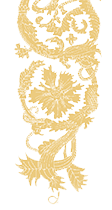19th Century Rosewood and Brass Inlaid Centre Table
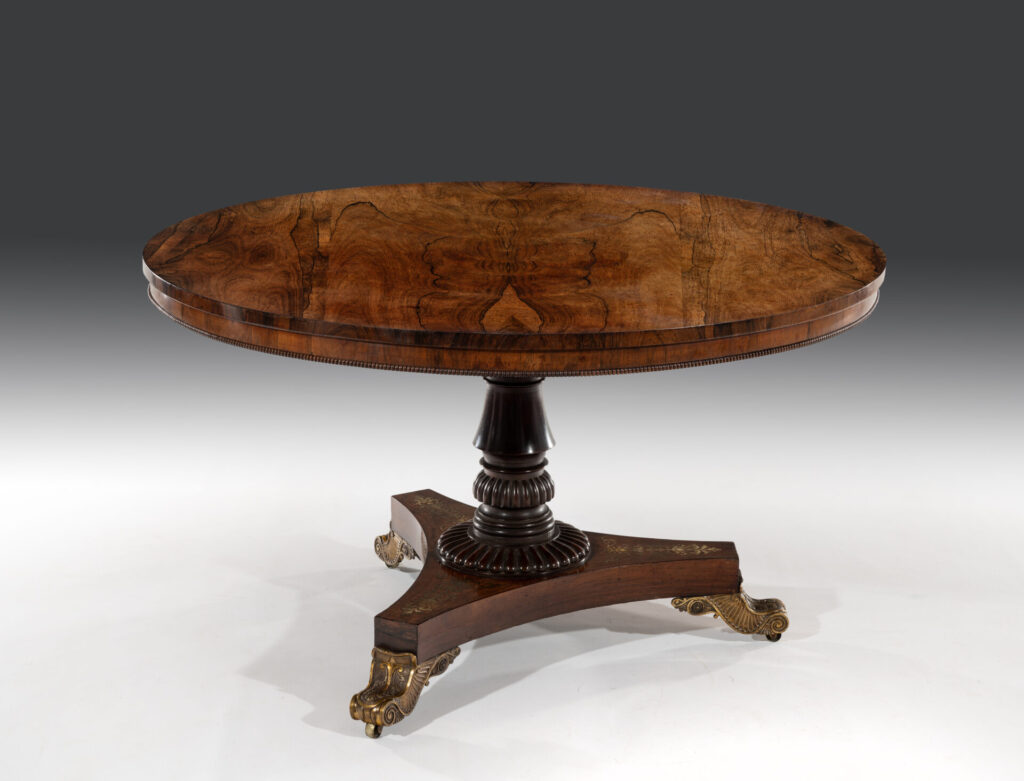
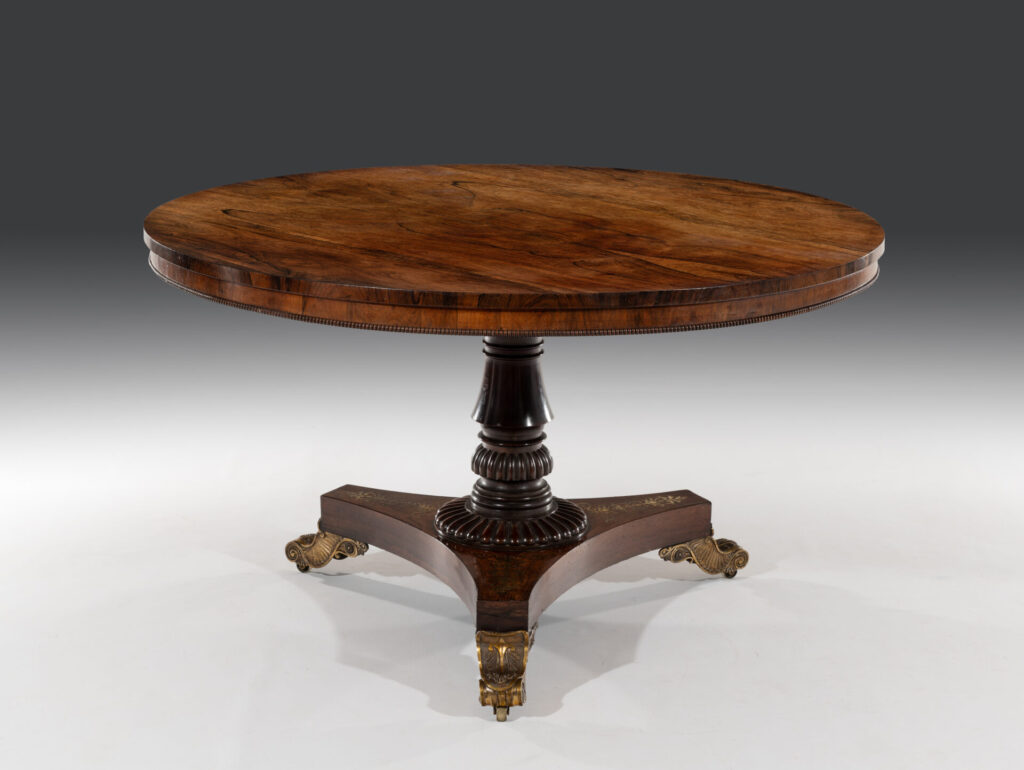
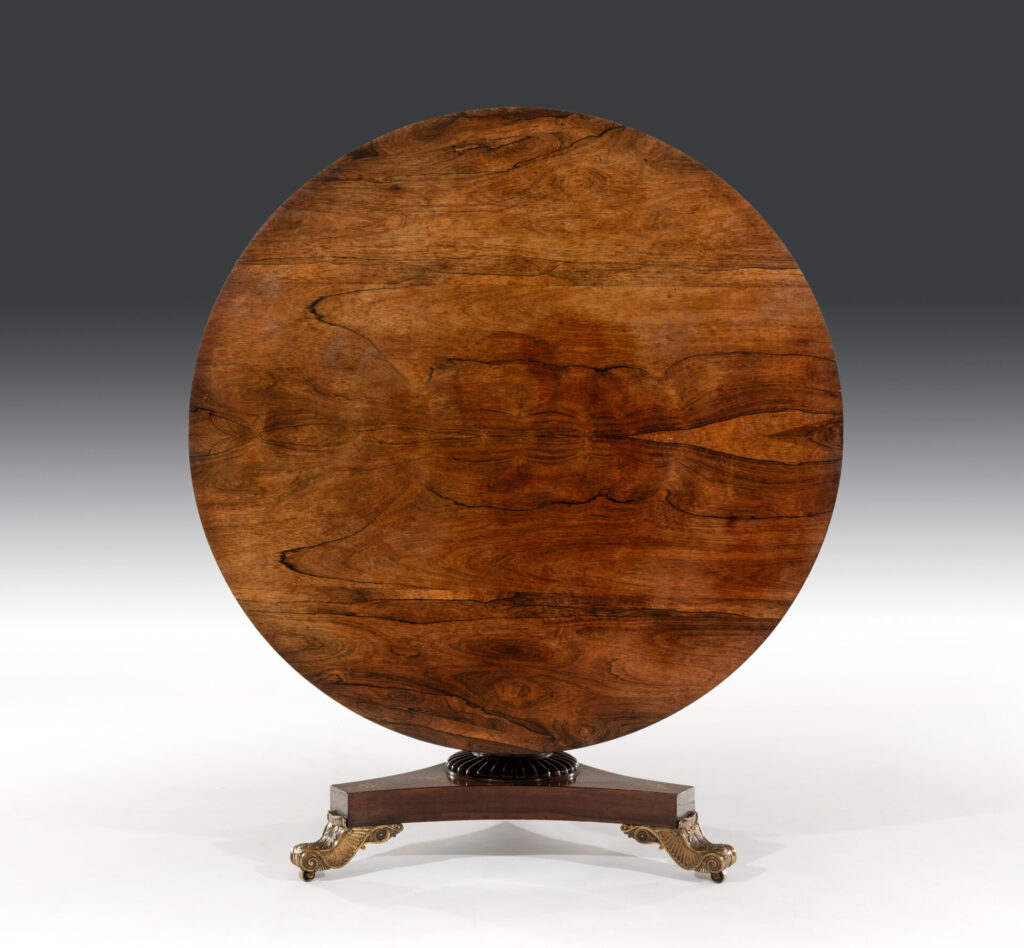
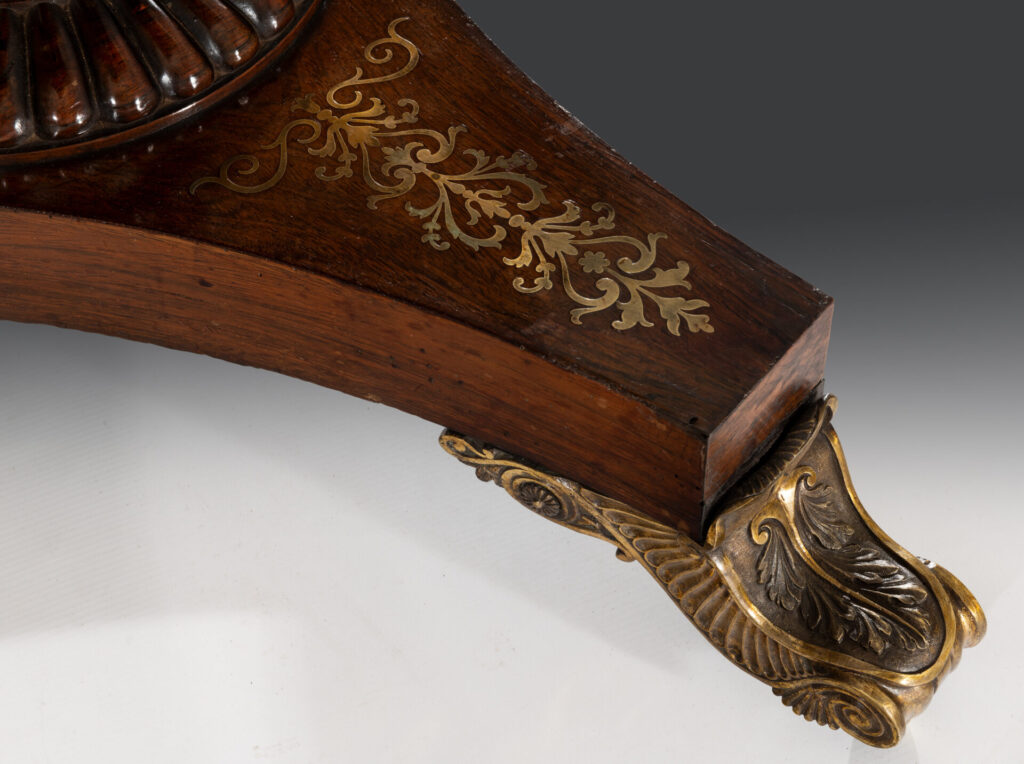
19th Century Rosewood and Brass Inlaid Centre Table
English
circa 1815 - 1825
Early 19th century Regency period brass inlaid circular centre table possibly William Trotter of Edinburgh.
A faded and well figured rosewood veneer has been book-matched with rosewood vertical cut veneer to a shallow gadrooned frieze.
The single gun barrel pedestal with ring turnings, gadrooning, and a shaped baluster above a brass inlaid rosewood veneered triform base. The plinth base is raised on the original crisply cared gilt brass feet and castors.
The table retains a lovely faded colour and is very much understated but gloriously elegant at the same time.
Literature
Trotter, William
Edinburgh; upholsterer, cabinet maker (b.1772-d.1833)
On 11 May 1805 the Caledonian Mercury announced that William, son of Thomas Trotter (fl.1747-1805) ‘succeeded to the Old Establishment’ of Young & Trotter, of which he ‘had been for nine years the Junior Partner’. The firm then started to work closely with various Edinburgh architects including William Playfair and James Gillespie Graham, architect of the Moray Estate and Lord Provost of the city 1825-27; Trotter was Lord Provost 1825-26.
In 1814-15 Trotter supplied Paxton Housewith a pair of ‘eliptic’ card tables and a rosewood stand, the claw designs followed nos. 9 & 6 in the London Cabinet-Makers’ Union Book of Prices (1811). For the Paxton commission George Home also engaged Trotter to make furniture from his estate-grown laburnum.
Trotter and the compilers of the Supplement to the Cabinet-Makers’ Book of Prices, Edinburgh (1825) illustrated the Scottish design of ‘Truss legs’; this was mentioned by Trotter in his estimate for a suite of lobby furniture for 3 Moray Place, Edinburgh, for Sir Duncan Campbell of Barcaldinec. 1825 ‘Handsome mahogany Lobby Table on truss legs 5 feet long’.
1818-20 Trotter supplied museum display cases and free-standing furniture for the Royal Museum, Edinburgh including: ‘6 Large Mahogany Tables with astragal ends of richly carved massive legs, the tops framed, and inlaid with fine crimson Cloth’. In 1822 for the visit of George IV the firm of William Trotter dismantled the rooms at Holyrood, which had been refurnished by the firm for the Comte D’Artois and his French entourage in 1796 and was paid £1,470 for supplying upholstery and new furniture. In 1824 he provided further casing for the ‘East Museum’, an extension to the Royal Museum; one of the smaller desk-cases is illus. Furniture History (2003), p. 125.
Trotter bought the estate of Ballindean, Inchture shortly after 1820 and in 1825 his neighbour, Francis, 14th Lord Gray commissioned Trotter to provide furniture and upholstery in ‘Chinese taste’ for Kinfauns Castle. The commission included Chinese silks, muslins and wallpaper as well as fine chairs and sofas in the Chinese taste. For the State Bedroom a winged wardrobe (cost £34 13s), chamber table, a double wash-hand table, a pair of ‘pedestal bedside tables’, three writing-tables and 2 ‘Japanned Claw footed linen airer[s]’ (all illus. Furniture History (1997), pp.243, 244 & 246). The centrepiece was the ‘Double Screwed Bedstead’ with its ‘Matt Gold and Japan’ columns, ‘carved Claws’ for feet and Chinese painted silk curtains in scarlet and green, cost over £100 (illus. Furniture History (1997). p. 245). The Dressing Room was furnished by Trotter with a couch bed and ‘2 Corner Cabinets with Chinese pavilion roof arch’d glazed doors...’, the latter cost £49 10s.
Trotter was an antiquarian bibliophile; when he copied the ‘Queen Mary’ chairs in 1838 for Thomas Dibdin he dated his version to ‘the style of James and Charles’. He embraced the Scottish Baronial Revival concept; for example, in 1822 he supplied tartan draperies for the Card Room at Edinburgh Assembly Hall in preparation for the visit by George IV. He also redecorated the Royal Apartments at Holyrood including the former quarters of the Comte D’Artois which his father had furnished in the 1790s.
His son, Charles Trotter, followed into his father's upholstery trade.
Sources: Bamford, ‘A Dictionary of Edinburgh Wrights and Furniture Makers 1660-1840’, Furniture History(1983); Jones, ‘Scottish Cabinet Makers’ Price Books, 1805-1825’, Regional Furniture (1989); Pryke, ‘A Study of the Edinburgh Furnishing Trade Taken from Contemporary Press Notices, 1708-1790’, Regional Furniture (1989); Pryke, ‘At the Sign of the Pelican’, Regional Furniture (1992); Jones, ‘The Laburnum Tradition in Scotland’, Regional Furniture (1992); Swain, ‘Furniture for the Comte d’Artois at Holyrood, 1796’, Furniture History (1992); Gow, ‘The Scotch Baronial Revival Interior’, Furniture History (1996); Jones, ‘William Trotter’s Furniture for the Chinese Rooms at Kinfauns Castle, Perthshire’, Furniture History (1997); Swinney, ‘Furnishing a Museum: Nineteenth-Century Exhibition Casing in the Royal Museum, Edinburgh’, Furniture History (2003); Jones and Purdy, ‘Irish Sideboards’, Regional Furniture (2005).
Dimensions
Height 72.00cm (28.35 inches)
Diameter 123.00cm (48.43 inches)
Stock No: 11483
Sold
